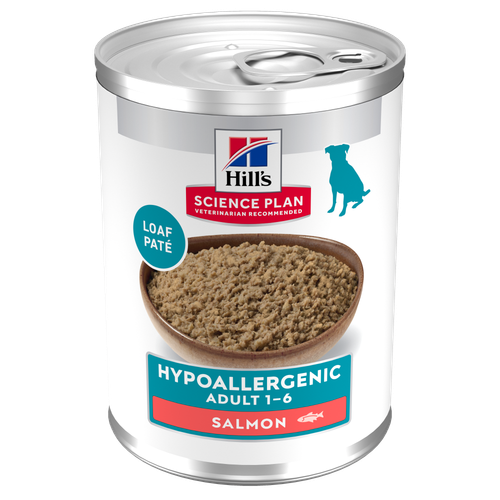
-
Find the right food for your petTake this quiz to see which food may be the best for your furry friend.Find the right food for your petTake this quiz to see which food may be the best for your furry friend.Featured products
 Adult Wet Dog Food with Beef
Adult Wet Dog Food with BeefHill's Science Plan Adult Multipack Wet Dog Food with Chicken, Beef & Turkey are complete premium pet foods for adult dogs from 1 year. Your dog will love these deliciously smooth and savoury minced loaves, formulated for balanced nutrition and overall health.
Shop Now Puppy Food
Puppy FoodHill's Science Plan Puppy Multipack Wet Dog Food with Chicken & Beef are complete premium pet foods for growing puppies from weaning until 1 year old and for pregnant and nursing dogs. Your puppy will love these deliciously smooth and savoury minced loaves, formulated for balanced nutrition and overall health.
Shop Now Mature Adult Dog Food
Mature Adult Dog FoodHill's Science Plan Mature Adult Multipack Wet Dog Food with Chicken & Beef are complete premium pet foods for mature adult dogs from 7 years. Your dog will love these deliciously smooth and savoury minced loaves, formulated to deliver the appropriate amount of energy to support the needs of adult dogs.
Shop NowFeatured products Mature Adult Wet Cat Food with Chicken
Mature Adult Wet Cat Food with Chicken
Tender chicken chunks in gravy for mature adult cats. Made with easy-to-digest ingredients, high-quality protein for lean muscle maintenance and antioxidant vitamins C+E for optimal health.
Shop Now Light Adult Multipack Wet Cat Food with Chicken & Ocean Fish
Light Adult Multipack Wet Cat Food with Chicken & Ocean FishTender chicken chunks in gravy for cats, with L-carnitine and fewer calories for ideal weight management. Packed with high-quality protein, omega-6s, and vitamin E for shiny fur and healthy skin.
Shop Now Adult Multipack Wet Cat Food with Beef, Ocean Fish & Chicken
Adult Multipack Wet Cat Food with Beef, Ocean Fish & ChickenTender chunks in gravy for cats, with high-quality protein to maintain lean muscle. With vitamin E and omega-3s & -6s for healthy skin and balanced minerals to support healthy vital organs.
Shop Now -
Dog
- Dog Tips & Articles
-
Health Category
- Weight
- Food & Environmental Sensitivities
- Urinary
- Digestive
- Joint
- Kidney
-
Life Stage
- Puppy Nutrition
- Adult Nutrition
- Senior Nutrition
Cat- Cat Tips & Articles
-
Health Category
- Weight
- Skin & Food Sensitivities
- Urinary
- Digestive
- Kidney
-
Life Stage
- Kitten Nutrition
- Adult Nutrition
Featured articles Show some love with wet foods: a great choice for pets with health issues
Show some love with wet foods: a great choice for pets with health issuesShow some love with wet foods: a great choice for pets with health issues.
Read More The Right Diet For Your Pet
The Right Diet For Your PetIn people, the right diet is very important. If you are eating the wrong way for your metabolism, activity level, age and lifestyle you could end up with health issues.
Read More The Incredible Science Behind Your Pet's Microbiome
The Incredible Science Behind Your Pet's MicrobiomeLearn what your pet's microbiome is, how it contributes to your pet's gut and overall health, and why nutrition is important in maintaining healthy microbiomes.
Read More -


Is your dog’s scratching driving them (and you!) to distraction? Does their skin look crusty or red? Do they have a rash, pimples, or an odour to their skin? They could have pyoderma, a common skin condition that affects dogs of all breeds, sizes and ages. If you're concerned that pyoderma could be wreaking havoc on your dog's skin, read on to learn more about common causes and treatments.
What is pyoderma in dogs?
Pyoderma is a bacterial infection, which can be superficial or deep, that affects hair follicles and the surrounding skin. If you break it down, "pyo" means pus, and "derma" means skin. Potential underlying causes of pyoderma in dogs include:
- A foreign body, like a grass seed, getting under the skin.
- A trauma or bite wound.
- Sensitivities to fleas, food, or environmental factors like pollen or dust mites (atopic dermatitis). Certain breeds, such as bulldogs, boxers and Labradors, are more prone to atopic dermatitis than others.
- Mites.
- A hormonal disorder, like Cushing's syndrome or hypothyroidism.
- An autoimmune disorder.
- Administration of immune-suppressing drugs, like steroids or chemotherapy.
Certain breeds have issues with skin folds, such as the Shar pei and the short-faced breeds with folds of skin on their face. When furry skin gets folded, the air can’t get in and the fold becomes moist and inflamed. This allows bacteria to thrive, causing issues like pyoderma. These cases of pyoderma can be difficult to spot because they’re hidden in the folds.
What are the symptoms of pyoderma in dogs?
Pyoderma can present itself in a variety of ways, depending on the cause. It can be limited to one area, or it may cover your dog's skin. Some areas of the body, such as skin folds, chins, lips, vulvar folds, and the skin in between the toes are more likely to be affected. Sometimes pyoderma is extremely itchy; other times, it doesn't seem to make a dog itchy at all. Signs of pyoderma to look out for include:
- Red bumps.
- Pustules.
- Flaking skin.
- Hair loss.
- Skin discolouration.
- Excessive shedding.
- Redness.
Puppies can get a special kind of pyoderma called puppy pyoderma. This tends to affect the less-hairy areas such as the armpits, groin and abdomen. These red bumps can scab over and scale. Puppy pyoderma can make your dog slightly itchy, but pups with puppy pyoderma are usually otherwise in good health.


Tasty Tips
What is the treatment for pyoderma in dogs?
Pyoderma is usually caused by Staphylococcus bacteria (or Staph). Unless your dog has a drug-resistant species, Staph infections are usually easily cleared up.
If your vet suspects pyoderma, they’ll first want to confirm this with a series of tests. They may take a variety of samples from the skin, like swabs and scrapes and possibly even biopsies. They will look under the microscope to look for bacteria and other organisms, such as mites, and may also send a sample to a specialised laboratory to determine the most effective antibiotic(s) to prescribe if necessary. They may also order a fungal culture or a black light test to rule out ringworm.
Once diagnosed, pyoderma is treated by resolving the bacterial infection. Pyoderma in dogs is directly treated with antimicrobial therapy — either oral antibiotics or topical antibacterial medication, shampoo, or spray applied to the affected area. The use of antibiotics should be kept to a minimum, so please follow your vet's instructions for these antibiotics closely.
You and your vet will also need to work together to determine and address the underlying cause of the infection, if applicable. There may be some trial and error involved; your vet may ask to take some blood, skin or urine samples from your dog. They may also want to do a food trial to rule out food sensitivities.
Does nutrition play a role?

Nutrition and your dog's food plays a large role in skin health. For example, the amino acids coming from dietary proteins are the building blocks for skin cells and hair, while fatty acids are key for maintaining coat quality and reducing water loss through the skin.
Some dogs may develop sensitivities to certain food ingredients, often a protein such as beef or chicken, which can lead to a secondary pyoderma. If your vet suspects a food sensitivity as the cause, they will need to treat the skin infection first. They may then recommend feeding your dog a dietetic food to see if the skin problem resolves. These trials are exclusion trials, so it’s very important that you don’t feed your dog anything else besides the special food. For skin conditions, the trial may need to last 8-10 weeks, so be prepared for the long haul and make sure the whole family is on board.
If your dog doesn't have food sensitivities, but has pyoderma secondary to other health concerns, like a hormonal disorder, then it may still be a good idea to feed your dog a food that's specially formulated for dogs with sensitive skin. It's important to talk to your veterinarian about the ideal food to make sure your dog receives the best nutrition possible. Good nutrition and using foods which support skin function can help to speed up recovery and minimise treatment costs.
Pyoderma is a pain, but with the right knowledge and care, it can be resolved. If your dog develops pyoderma, especially more than once, understand that you're dealing with an underlying issue that needs resolution. If you notice any signs of this infection, call your vet, who will work with you to get your dog feeling like their best self again.


Dr. Sarah Wooten graduated from UC Davis School of Veterinary Medicine in 2002. A member of the American Society of Veterinary Journalists, Dr. Wooten divides her professional time between small animal practice in Greeley, Colorado, public speaking on associate issues, leadership, and client communication, and writing. She enjoys camping with her family, skiing, SCUBA, and participating in triathlons.
Related products

Hill's Science Plan Hypoallergenic Adult Wet Dog Food with Salmon is a complete premium pet food for all adult dogs from 1 year. This savoury tinned loaf is specially formulated for dogs with delicate skin and stomachs. It features a single novel animal protein source and is grain-free.

Hill's Science Plan Adult Multipack Wet Dog Food with Chicken, Beef & Turkey are complete premium pet foods for adult dogs from 1 year. Your dog will love these deliciously smooth and savoury minced loaves, formulated for balanced nutrition and overall health.

Hill's Science Plan Mature Adult Multipack Wet Dog Food with Chicken & Beef are complete premium pet foods for mature adult dogs from 7 years. Your dog will love these deliciously smooth and savoury minced loaves, formulated to deliver the appropriate amount of energy to support the needs of adult dogs.

Hill's Science Plan Puppy Multipack Wet Dog Food with Chicken & Beef are complete premium pet foods for growing puppies from weaning until 1 year old and for pregnant and nursing dogs. Your puppy will love these deliciously smooth and savoury minced loaves, formulated for balanced nutrition and overall health.
Related articles

Learn effective tips for feeding a dog that's a picky eater and ensure proper nutrition for a finicky eater. Discover tips for pet parents at Hill's Pet UK.

Many human foods are dangerous to dogs. Read about 5 of the worst toxic food offenders that can kill your dog - and how much it takes to hurt them.

Learn about the potential health risks of a raw diet for dogs and why they aren't the best option for your pup or you.

How, when and what to feed your new puppy is an important decision, learn more about the things to consider for feeding your puppy.

Put your dog on a diet without them knowing
Our low calorie formula helps you control your dog's weight. It's packed with high-quality protein for building lean muscles, and made with purposeful ingredients for a flavourful, nutritious meal. Clinically proven antioxidants, Vitamin C+E, help promote a healthy immune system.
Put your dog on a diet without them knowing
Our low calorie formula helps you control your dog's weight. It's packed with high-quality protein for building lean muscles, and made with purposeful ingredients for a flavourful, nutritious meal. Clinically proven antioxidants, Vitamin C+E, help promote a healthy immune system.


